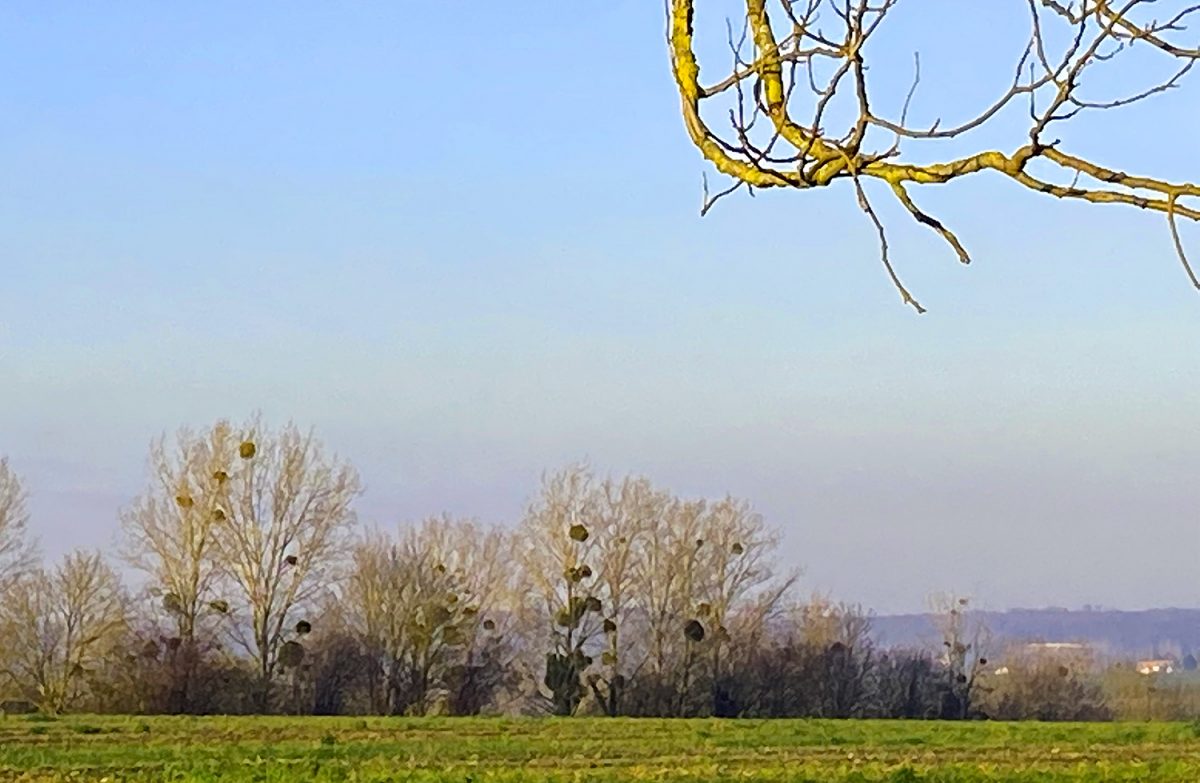
Au Gui l’An Neuf is another way, a bit old fashioned, to say Bonne et heureuse année à vous.
La saison voulant que le gui abonde, on en cueillit dès le Moyen Âge pour l’offrir avec ce souhait : « Au gui l’an neuf », formule qui fut remplacée plus tard par « Bon an, mal an, Dieu soit céans » (soit dans la maison). Au XIXe siècle on disait « Bonne et sainte année, le paradis à la fin de vos jours », expression modernisée au XXe siècle en « Bonne et heureuse année ».
Mistletoe grows all over northern France and on six of the seven continents. It’s those balls in the bare trees that you think might be nests at first glance, but in fact it is vegetal parasite which rarely kills the host trees and thus is not a pest. Ecologically it is an important plant as it provides food and shelter for many species. A study in Australia mentioned in the NY Times compared forest parcels with mistletoe to parcels from which mistletoe had been removed. The study suggests that mistletoe is important to all creatures of the forest because of its evergreen leaves amongst the deciduous trees. The parcels with mistletoe had more birds, mammals, reptiles and insects thus generally healthier and with greater diversity.
Viscum album, as the bontantists say, has lived on Earth for millions of years and was considered as a sacred plant by the druids who believed it to have miraculous properties. The winter season reaveals the mistletoe in the trees. The druids used it ward off curses. They considered mistletoe to be sacred and miraculous because it was the only known plant giving fruit. The fruits are toxic for humans, but very popular with thrushes and other fauna. In fact, for a long time, the Druids believed that the water in which mistletoe was soaked made all the creatures that drank it fruitful. Another belief was that, whenever enemies met under the mistletoe in the forest, they had to lay down their arms and observe a truce until the next day. Hanging a ball of mistletoe from the ceiling thus became a widespread custom, and exchanging kisses under it was a sign of friendship and goodwill.
In the Middle Ages mistletoe was gathered and given with the following wish: « Au gui l’an neuf » (« To the mistletoe the new year »), a formula which was replaced later by « Bon an, mal an, Dieu soit céans » (céans = dans la maison). In English « Good year, bad year, may God be here » . In the 19th century the French would say « Bonne et sainte année, le paradis à la fin de vos jours » (« Happy New Year, blessed new year, may paradise be at the end of your days »). This expression was simplified in the 20th century to « Bonne et heureuse année » or « Happy New Year ».

Nowadays, the custom of exchanging a kiss under the mistletoe still exists in many European countries as well as in Canada and the US, with different interpretation: for a couple in love, it is a promise to marry, as well as a prediction of happiness and long life.
In France, the custom used to be reserved for New Year’s Day: «Mistletoe for the New Year» (Au gui l’An neuf), but today, kisses can be exchanged under the mistletoe any time during the holiday season, although in the curent situation it is better to just verbally wish Au gui l’An neuf!
Read about other French idiomatic expressions in our other articles on the French language: https://fusac.fr/category/language/ and Happy New Year from FUSAC and Bill & Rosa’s Book Room.
Q) What did the astronaut get when the rocket fell on his foot?
A) Mistletoe! hee hee


